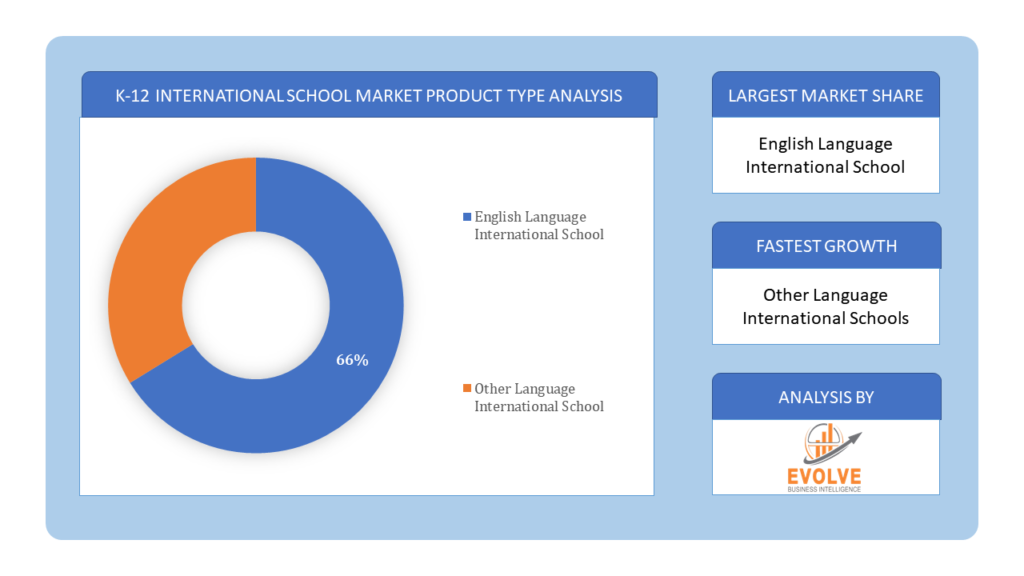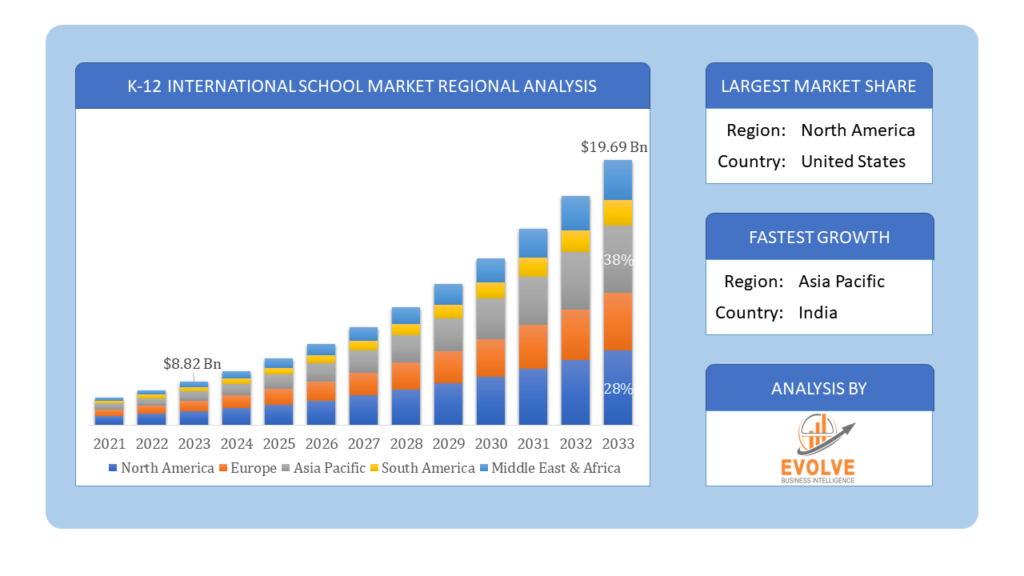K-12 International Schools Market Overview
The K-12 International Schools industry size accounted for USD 7.95 Billion in 2023 and is expected to expand at a compound annual growth rate (CAGR) of 8.36% from 2023 to 2033. K-12 International Schools are educational institutions that provide comprehensive education from kindergarten through 12th grade, following an international curriculum designed to cater to students from various cultural backgrounds. These schools often implement globally recognized educational frameworks such as the International Baccalaureate (IB), Cambridge International Examinations (CIE), or American Advanced Placement (AP) programs. K-12 International Schools aim to foster a multicultural environment, promote multilingualism, and prepare students for higher education and global citizenship. They primarily serve expatriate families, diplomats, and local families seeking an international education for their children.
Global K-12 International Schools Market Synopsis
The COVID-19 pandemic had a profound impact on K-12 International Schools, causing widespread disruptions and necessitating quick adjustments in teaching and learning methods. Schools had to shut down their physical campuses, prompting a rapid shift to online learning. This transition exposed challenges related to digital infrastructure, technology access, and varying levels of digital literacy among students and teachers. The pandemic also affected student enrollment and school finances, as many expatriate families relocated or faced economic hardships. Additionally, implementing health and safety protocols, such as social distancing and hybrid learning models, added operational complexities. Despite these challenges, the pandemic accelerated the adoption of technology in education and highlighted the importance of flexible and resilient educational models.
K-12 International Schools Market Dynamics
The major factors that have impacted the growth of K-12 International Schools are as follows:
Drivers:
- Growing Demand for Quality International Education
A major driver for the K-12 International Schools market is the increasing demand from expatriate families, local affluent families, and international professionals seeking high-quality, globally recognized education for their children. This demand is fueled by the desire for multilingual proficiency, multicultural exposure, and globally relevant curricula that prepare students for higher education and international careers.
Restraint:
- High Cost of Tuition
A significant restraint in the K-12 International Schools market is the high cost of tuition, which can limit accessibility for many families. These schools often have higher operational costs due to their international curricula, experienced faculty, and extensive facilities, leading to higher tuition fees that may not be affordable for all potential students.
Opportunity:
⮚ Expansion into Emerging Markets
There is a substantial opportunity for the expansion of K-12 International Schools into emerging markets, such as parts of Asia, Latin America, and the Middle East & Africa. Increasing economic growth, urbanization, and a rising middle class in these regions are driving demand for high-quality international education, presenting opportunities for new school openings and partnerships to cater to the growing market.
K-12 International Schools Segment Overview
By Product Type
 Based on Product Type, the market is segmented based on English Language International School, Other Language International School. In the K-12 International Schools market, English Language International School offerings dominate due to their global appeal and high demand among expatriate and local families seeking an English-medium education. These schools provide globally recognized curricula, enhancing their attractiveness and market leadership.
Based on Product Type, the market is segmented based on English Language International School, Other Language International School. In the K-12 International Schools market, English Language International School offerings dominate due to their global appeal and high demand among expatriate and local families seeking an English-medium education. These schools provide globally recognized curricula, enhancing their attractiveness and market leadership.
By Application
Based on Applications, the market has been divided into the Pre-primary School, Primary School, Middle Schools, High School. In the K-12 International Schools market, the Pre-primary School segment dominates, driven by increasing parental awareness of the importance of early childhood education and the demand for high-quality, bilingual early learning environments. This segment benefits from the growing emphasis on foundational learning and development.
Global K-12 International Schools Market Regional Analysis
Based on region, the global K-12 International Schools market has been divided into North America, Europe, Asia-Pacific, the Middle East & Africa, and Latin America. North America is projected to dominate the use of the K-12 International Schools market followed by the Asia-Pacific and Europe regions.
 K-12 International Schools North America Market
K-12 International Schools North America Market
North America holds a dominant position in the K-12 International Schools Market due to several factors. The region boasts a well-established network of international schools, particularly in major metropolitan areas, catering to the diverse needs of expatriate families, diplomats, and local residents seeking globally oriented education. North America’s strong economy, cultural diversity, and high standards of education contribute to its appeal as a destination for international schooling. Additionally, the presence of renowned international education systems, such as the International Baccalaureate (IB) and Cambridge International Examinations (CIE), further enhances the region’s attractiveness for international students. Furthermore, favorable government policies, robust infrastructure, and a stable socio-political environment support the growth and sustainability of K-12 International Schools in North America.
K-12 International Schools Asia-Pacific Market
The Asia-Pacific region has indeed emerged as the fastest-growing market for the K-12 International Schools industry, driven by several key factors. Rapid economic development, urbanization, and a burgeoning middle class in countries such as China, India, and Southeast Asian nations have led to increased demand for high-quality education. Moreover, the region’s growing expatriate population, coupled with the aspirations of local families for global education standards, has fueled the proliferation of international schools. Additionally, government initiatives promoting education reform and internationalization have further stimulated market growth. The Asia-Pacific’s strategic importance as a hub for global trade and investment also attracts multinational families seeking international schooling options for their children, contributing to the region’s prominence in the K-12 International Schools industry.
Competitive Landscape
The global K-12 International Schools market is highly competitive, with numerous players offering a wide range of software solutions. The competitive landscape is characterized by the presence of established companies, as well as emerging startups and niche players. To increase their market position and attract a wide consumer base, the businesses are employing various strategies, such as Offerings launches, and strategic alliances.
Prominent Players:
- COGNITA SCHOOLS
- MAPLE LEAF EDUCATIONAL SYSTEMS
- NORD ANGLIA EDUCATION
- ACS INTERNATIONAL SCHOOLS
- BRAEBURN SCHOOLS
- DULWICH COLLEGE INTERNATIONAL
- ESOL EDUCATION
- HARROW INTERNATIONAL SCHOOLS
- WELLINGTON COLLEGE
Scope of the Report
Global K-12 International Schools Market, by Product Type
- English Language International School
- Other Language International School
Global K-12 International Schools Market, by Application
- Pre-primary School
- Primary School
- Middle Schools
- High School
Global K-12 International Schools Market, by Region
- North America
- US
- Canada
- Mexico
- Europe
- UK
- Germany
- France
- Italy
- Spain
- Benelux
- Nordic
- Rest of Europe
- Asia Pacific
- China
- Japan
- South Korea
- Indonesia
- Austalia
- Malaysia
- India
- Rest of Asia Pacific
- South America
- Brazil
- Argentina
- Rest of South America
- Middle East & Africa
- Saudi Arabia
- UAE
- Egypt
- South Africa
- Rest of Middle East & Africa
| Parameters | Indicators |
|---|---|
| Market Size | 2033: $2.41 Billion |
| CAGR | 8.36% CAGR (2023-2033) |
| Base year | 2022 |
| Forecast Period | 2023-2033 |
| Historical Data | 2021 |
| Report Coverage | Revenue Forecast, Competitive Landscape, Growth Factors, and Trends |
| Key Segmentations | Product Type, Application |
| Geographies Covered | North America, Europe, Asia-Pacific, Latin America, Middle East, Africa |
| Key Vendors | COGNITA SCHOOLS, MAPLE LEAF EDUCATIONAL SYSTEMS, NORD ANGLIA EDUCATION, ACS INTERNATIONAL SCHOOLS, BRAEBURN SCHOOLS, DULWICH COLLEGE INTERNATIONAL, ESOL EDUCATION, HARROW INTERNATIONAL SCHOOLS, WELLINGTON COLLEGE |
| Key Market Opportunities | • Expansion into Emerging Markets |
| Key Market Drivers | • Increasing Demand for Quality International Education |
REPORT CONTENT BRIEF:
- High-level analysis of the current and future K-12 International Schools market trends and opportunities
- Detailed analysis of current market drivers, restraining factors, and opportunities in the future
- K-12 International Schools market historical market size for the year 2021, and forecast from 2023 to 2033
- K-12 International Schools market share analysis at each Offerings level
- Competitor analysis with detailed insight into its Offerings segment, Government & Defense strength, and strategies adopted.
- Identifies key strategies adopted including Offerings launches and developments, mergers and acquisitions, joint ventures, collaborations, and partnerships as well as funding taken and investment done, among others.
- To identify and understand the various factors involved in the global K-12 International Schools market affected by the pandemic
- To provide a detailed insight into the major companies operating in the market. The profiling will include the Government & Defense health of the company’s past 2-3 years with segmental and regional revenue breakup, Offerings offering, recent developments, SWOT analysis, and key strategies.
Frequently Asked Questions (FAQ)
What is the growth rate of the K-12 International Schools Market?
The K-12 International Schools Market is expected to expand at a compound annual growth rate (CAGR) of 8.36% from 2023 to 2033.
Which region has the highest growth rate in the K-12 International Schools Market?
The Asia-Pacific region has the highest growth rate in the K-12 International Schools Market, driven by economic development and rising demand for international education.
Which region has the largest share of the K-12 International Schools Market?
North America holds the largest share of the K-12 International Schools Market, supported by a well-established network of international schools and high demand.
Who are the key players in the K-12 International Schools Market?
Key players in the K-12 International Schools Market include Cognita Schools, Maple Leaf Educational Systems, Nord Anglia Education, ACS International Schools, Braeburn Schools, Dulwich College International, ESOL Education, Harrow International Schools, and Wellington College.
Do you offer Post sales support?
Yes, we offer 16 hours of analyst support to solve the queries
Do you sell particular sections of a report?
Yes, we provide regional as well as country-level reports. Other than this we also provide a sectional report. Please get in contact with our sales representatives.







